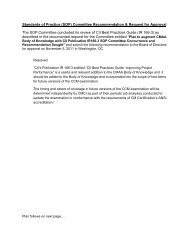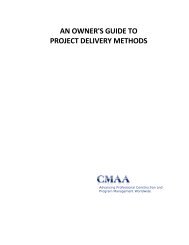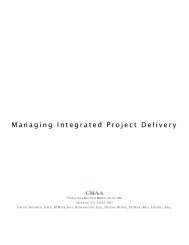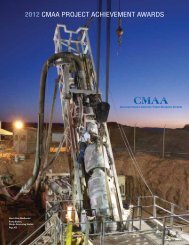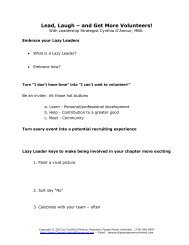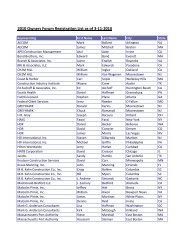FMI/CMAA Tenth Annual Survey of Owners
FMI/CMAA Tenth Annual Survey of Owners
FMI/CMAA Tenth Annual Survey of Owners
Create successful ePaper yourself
Turn your PDF publications into a flip-book with our unique Google optimized e-Paper software.
By 2014, a general increase in outsourcing is expected across all phases <strong>of</strong> construction (Exhibit 7). Notably, public agenciesat the federal and state level expect outsourcing to level <strong>of</strong>f. It is not clear what is driving this change, but a number <strong>of</strong> areasare in motion that are likely impacting it. First, based upon <strong>FMI</strong>’s analysis <strong>of</strong> the American Recovery and Reinvestment Act(ARRA), only about 10 percent <strong>of</strong> the $787 billion in stimulus spending will go directly to execute construction. 3 This figureprimarily represents spending at about the high water mark for many public agencies, not a significant increase in spendingand the related increase in outsourcing. Second and perhaps more important, the plans regarding how these and other fundswill be spent are in flux. The Obama administration seems antagonistic towards outsourcing <strong>of</strong> program management and constructionmanagement functions. Following the release <strong>of</strong> a memorandum from the White House titled “Memorandum for theHeads <strong>of</strong> Executive Departments and Agencies – Government Contracting” on March 4, 2009, the President completed a pressconference where he said, “We will stop outsourcing services that should be performed by the government and open up thecontracting process to small businesses. We will end unnecessary no-bid and cost-plus contracts that run up a bill that is paidby the American people.” 4 The General Administration Services (GSA) apparently took heed <strong>of</strong> President Obama’s words andannounced the creation <strong>of</strong> a nationally managed, regionally executed program management <strong>of</strong>fice to support the delivery <strong>of</strong>stimulus projects using more internal resources. 5 Federal agencies anticipate less outsourcing through 2014, perhaps due toefforts previously described that encourage internal resource use.Exhibit 72014 Percent <strong>of</strong> Outsourcing by Phase <strong>of</strong> Construction Compared with Organization Type90%80%70%60%50%40%30%20%10%0%% <strong>of</strong>Pre-Design% <strong>of</strong>DesignOversight% <strong>of</strong>DesignServices% <strong>of</strong>ProcurementServices% <strong>of</strong>ConstructionOversight% <strong>of</strong>ConstructionPerformance% <strong>of</strong>ProgramActivation% <strong>of</strong>Operations andMaintenance% <strong>of</strong> Outsourcing by PhaseFederal AgencyMunicipal AuthorityPrivate/Closely HeldPublicly Traded CorporationQuasi-PublicState AgencyAverage All3 Jones, Heather, <strong>FMI</strong>’s Construction Outlook First Quarter 2009 Report, March 2009, pg. 1.4 Obama, Barack, President <strong>of</strong> the United States, Press Conference, March 5, 2009.5 Prouty, Paul, Acting Administrator General Services Administration, Testimony before the Committee on Transportation and Infrastructure,U.S. House <strong>of</strong> Representatives, April 29, 2009.215<strong>FMI</strong>/<strong>CMAA</strong> <strong>Tenth</strong> <strong>Annual</strong> <strong>Survey</strong> <strong>of</strong> <strong>Owners</strong>



